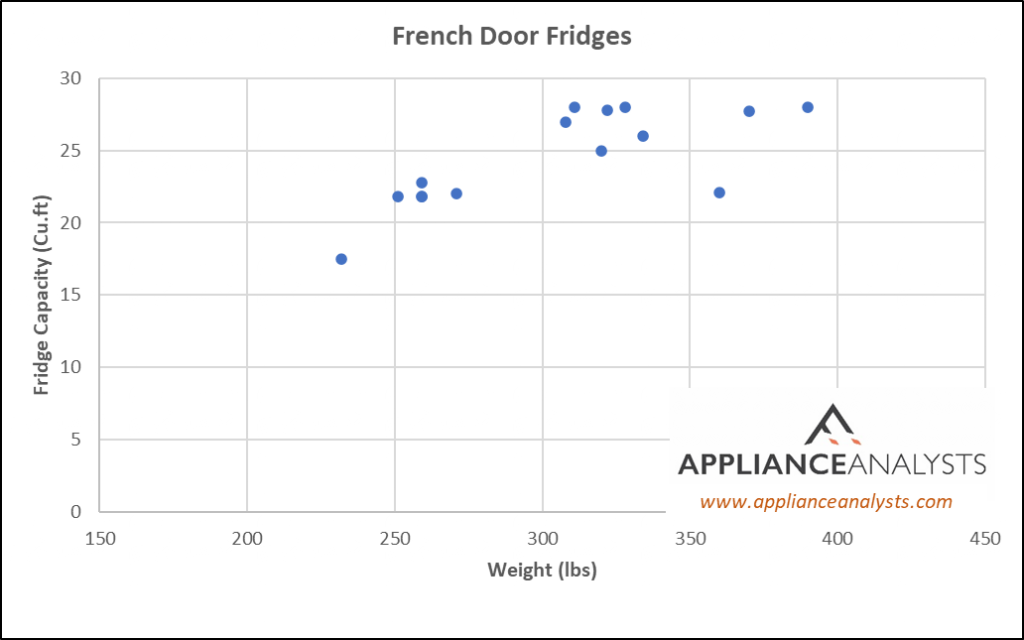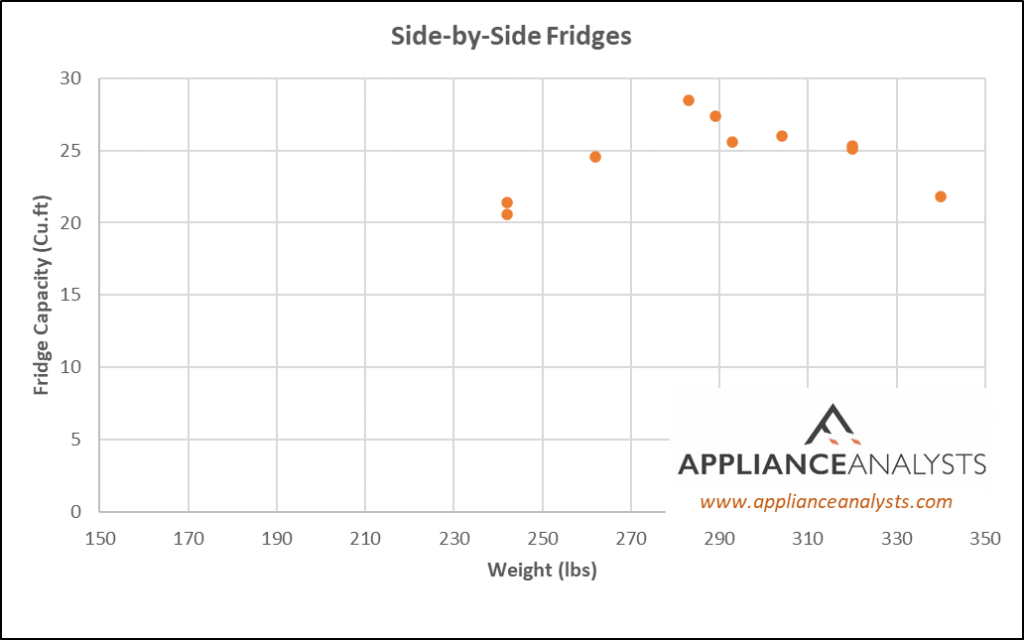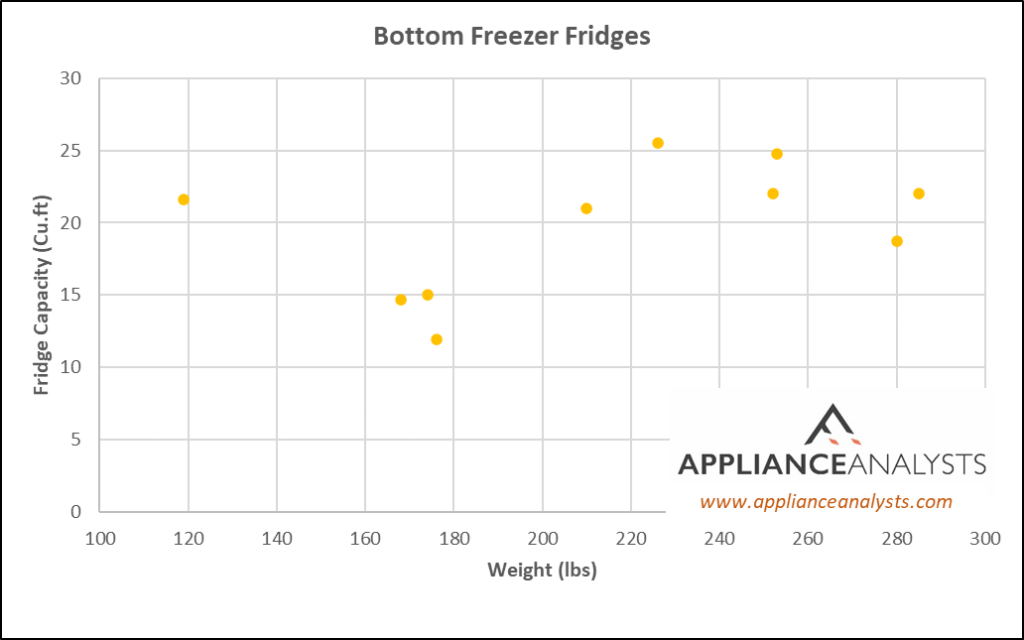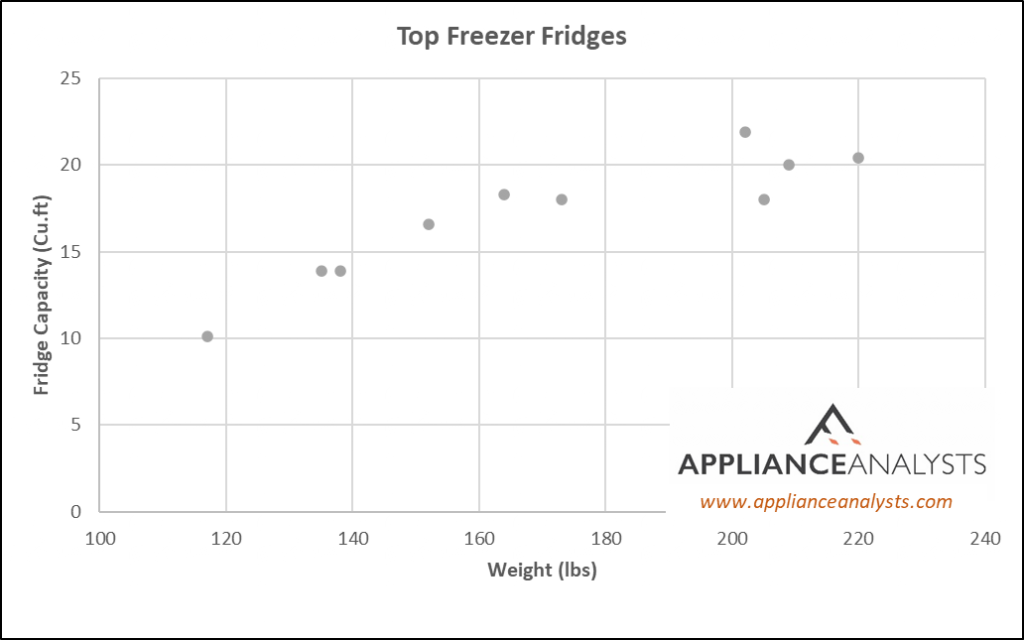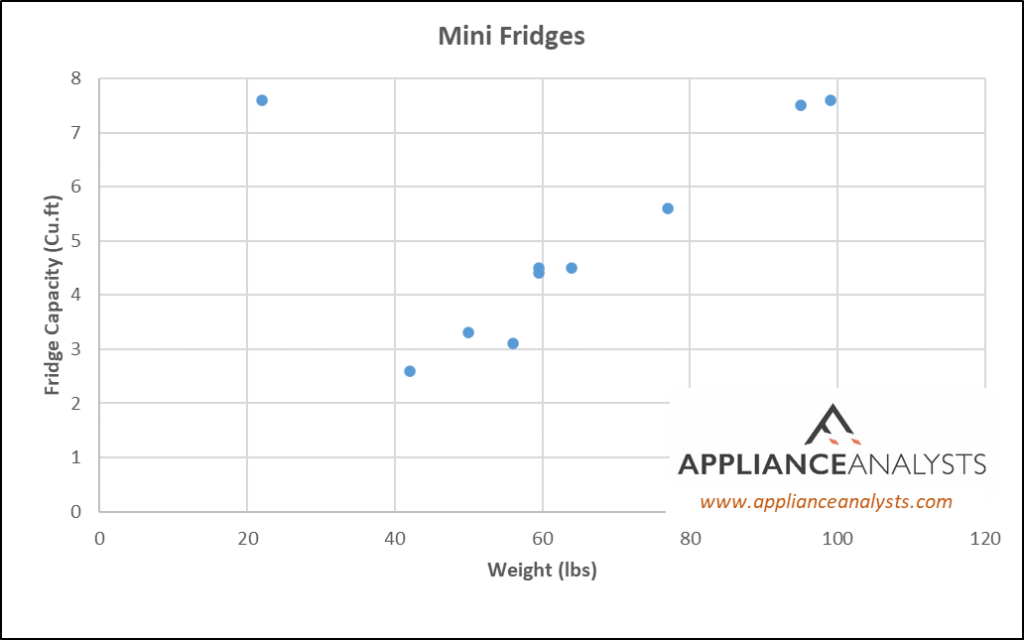Fridges are heavy. We all know that.
But just how heavy are they? Will you be able to get it in the car, the moving truck, or even just carry it?
I was curious about this, so I dove into some research. I’ve looked up the statistics for over 50 refrigerators to find out how much each type weighs.
The average refrigerator weighs 250lbs – depending on the type of fridge. French Door refrigerators weigh 305lbs on average, side by side refrigerators are 290lbs on average, and mini fridges are just 60lbs on average. Refrigerator weight depends on size, type, and the ice dispenser.
Here’s a quick summary of the averages of each type:
| Image | Refrigerator Type | Number Reviewed | Average Weight (lbs) | Average Weight (kg) |
|---|---|---|---|---|
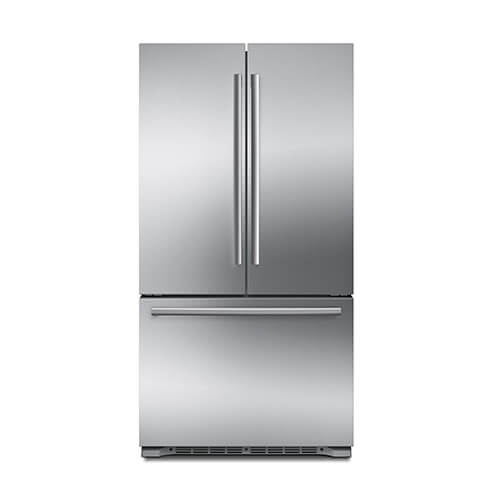 |
French Door Fridges | 15 | 305lbs | 138kg |
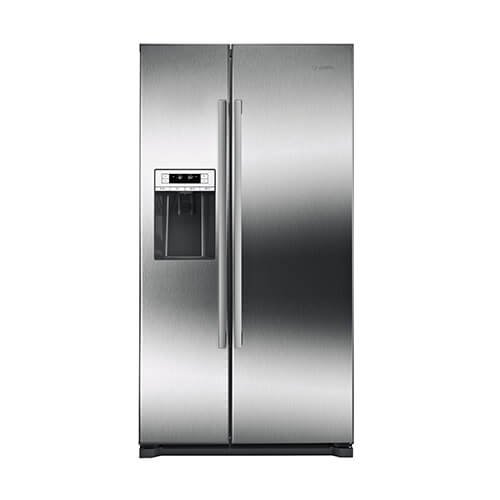 |
Side by Side Fridges | 10 | 290lbs | 131kg |
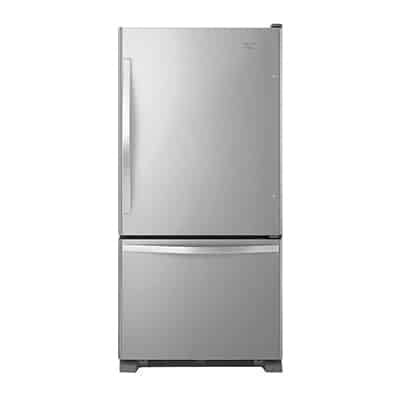 |
Bottom Freezer Fridges | 10 | 214lbs | 85kg |
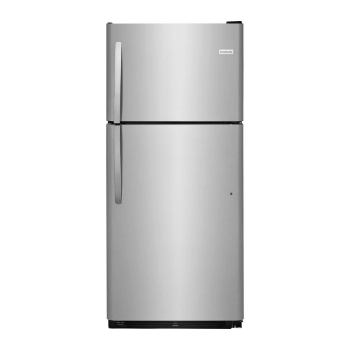 |
Top Freezer Fridges | 10 | 171lbs | 80kg |
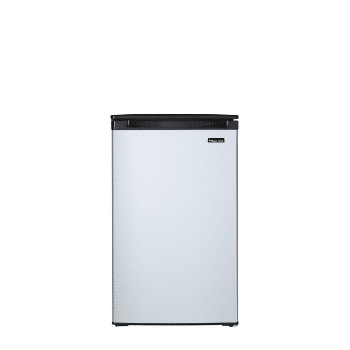 |
Mini Fridges | 10 | 62lbs | 27kg |
Those French Door Fridges sure are heavy.
Interested in a little more detail? Good, me too. Let’s dive in.
Refrigerator Weights by Type
How much a refrigerator weighs of course depends on it’s overall size, but also the type of fridge and whether it has added features like an ice dispenser and water filter. All of these contribute to the overall weight of a refrigerator.
For that reason we’ve separated each refrigerator type into it’s own weight category. Let’s get started with the heaviest fridges first.
How Much Do French Door Refrigerators Weigh?
Let’s start with the bulkiest type and work backwards. Here’s the stats for the 15 French Door refrigerator weights graphed against capacity in cubic feet.
Total capacity (fridge+freezer) is on the vertical axis, plotted against the fridge weight.
As you can see, the fridge weight increases with capacity – with an average weight of 305lbs (90kg). Interestingly, it doesn’t seem to increase according to height – that’s more of a design thing.
What does influence the refrigerator weight (as well as capacity) is fridge depth and ice makers. If it’s a counter depth model (29″ deep instead of 33″), the fridge weighs around 60lbs less. Similarly, an ice maker tends to push the empty weight up by another 20lbs or so.
Raw Data:
| Type | Brand | Capacity (cu.ft) | Height (in) | Depth (in) | Weight (lbs) | Ice Maker | Link |
|---|---|---|---|---|---|---|---|
| French | Samsung | 17.5 | 70 | 28 | 232 | No | Link |
| French | LG | 21.8 | 68.5 | 33 | 259 | No | Link |
| French | LG | 21.8 | 68.5 | 33 | 259 | No | Link |
| French | Samsung | 21.8 | 66.75 | 35 | 251 | No | Link |
| French | RCA | 22 | 68 | 29 | 271 | Yes | Link |
| French | GE | 22.1 | 70.5 | 30 | 360 | Yes | Link |
| French | LG | 22.8 | 70 | 29 | 259 | No | Link |
| French | Whirlpool | 25 | 68.6 | 32 | 320 | Yes | Link |
| French | LG | 26 | 69.75 | 32.5 | 334 | No | Link |
| French | GE | 27 | 68.6 | 33 | 308 | No | Link |
| French | GE | 27.7 | 70.5 | 34.5 | 370 | Yes | Link |
| French | LG | 27.8 | 70 | 34 | 322 | Yes | Link |
| French | Samsung | 28 | 70 | 33.5 | 311 | Yes | Link |
| French | Samsung | 28 | 68.8 | 34 | 328 | Yes | Link |
| French | GE | 28 | 70 | 34 | 390 | Yes | Link |
How Much Do Side-By-Side Refrigerators Weigh?
Onto a massively popular type, and the one we’re glad to have at home. Here’s the 10 Side by Side refrigerator weights graphed against capacity in cubic feet.
Once again, I found capacity to be the best correlation with refrigerator weight.
Coming in an average of 15lbs less than French door fridges, side by side models are still on the bulky side with 290lbs average weight (83kg).
Again, as well as capacity, the refrigerator depth also correlates with weight – counter-depth models weighing around 50lbs less than full depth models. Ice makers come standard with almost any good side-by-side model nowadays, so we can’t see the influence of them here.
Raw Data:
| Type | Brand | Capacity (cu.ft) | Height (in) | Depth (in) | Weight (lbs) | Ice Maker | Link |
|---|---|---|---|---|---|---|---|
| Side | Samsung | 27.4 | 70 | 33.5 | 289 | Yes | Link |
| Side | Whirlpool | 24.55 | 69 | 31.6 | 262 | Yes | Link |
| Side | GE | 25.3 | 69.5 | 33 | 320 | Yes | Link |
| Side | LG | 26 | 70 | 34 | 304 | Yes | Link |
| Side | GE | 21.8 | 69.5 | 29 | 340 | Yes | Link |
| Side | Whirlpool | 21.4 | 66 | 31.6 | 242 | Yes | Link |
| Side | Whirlpool | 28.5 | 69 | 33 | 283 | Yes | Link |
| Side | Frigidare | 25.6 | 69.6 | 32 | 293 | Yes | Link |
| Side | GE | 25.1 | 70.1 | 33 | 320 | Yes | Link |
| Side | Whirlpool | 20.6 | 68.6 | 27.5 | 242 | Yes | Link |
How Much Do Bottom Freezer Refrigerators Weigh?
Next up on the list are fridges with freezers in the bottom. Here’s the 10 Bottom Freezer refrigerator weights graphed against capacity in cubic feet.
Interestingly, these seem to be more split into different weight/capacity categories than having a linear relationship with weight.
Despite having similar height (~70 inches) and depth (up to 33 inches) as French Door and Side by Side fridges, Bottom Freezer model weigh considerably less with an average of 214lbs (90lbs less than the French Door average).
Raw Data:
| Type | Brand | Capacity (cu.ft) | Height (in) | Depth (in) | Weight (lbs) | Ice Maker | Link |
|---|---|---|---|---|---|---|---|
| Bottom | LG | 25.5 | 70 | 33 | 226 | No | Link |
| Bottom | Whirlpool | 22 | 70 | 31 | 252 | No | Link |
| Bottom | GE | 24.8 | 70 | 35 | 253 | No | Link |
| Bottom | Haier | 15 | 67.8 | 26.6 | 174 | No | Link |
| Bottom | Whirlpool | 18.7 | 67 | 31 | 280 | No | Link |
| Bottom | GE | 11.9 | 70 | 26.5 | 176 | No | Link |
| Bottom | GE | 21 | 70 | 34.1 | 210 | No | Link |
| Bottom | LG | 14.7 | 67.8 | 27.4 | 168 | No | Link |
| Bottom | Unique | 21.6 | 71 | 24.2 | 119 | No | Link |
| Bottom | Amana | 22 | 70 | 30.9 | 285 | No | Link |
How Much Do Top Freezer Refrigerators Weigh?
Time for the old-classic fridges that have small freezer sections on top. Here’s the 10 Top Freezer refrigerator weights graphed against capacity in cubic feet.
Isn’t a clear relationship on a graph just lovely? Capacity to Weight ratio confirmed.
Considerably shorter, shallower, and narrower than the models above, these Top Freezer Fridges come in at an average of just 172lbs.
They’re more suited to a small apartment or even a garage/entertaining room than a full-sized home. In fact, with an average capacity of 17 cubic feet, they’re only around 70% of the average French Door fridge.
Raw Data:
| Type | Brand | Capacity (cu.ft) | Height (in) | Depth (in) | Weight (lbs) | Ice Maker | Link |
|---|---|---|---|---|---|---|---|
| Top | Magic Chef | 10.1 | 59.4 | 26 | 117 | No | Link |
| Top | GE | 21.9 | 66.4 | 32.3 | 202 | No | Link |
| Top | GE | 16.6 | 65 | 30.5 | 152 | No | Link |
| Top | Frigidaire | 13.9 | 60.5 | 25 | 138 | No | Link |
| Top | Frigidaire | 18.3 | 66.4 | 26.6 | 164 | No | Link |
| Top | Whirlpool | 20 | 66 | 30.6 | 209 | No | Link |
| Top | Whirlpool | 18 | 67.4 | 31.6 | 173 | No | Link |
| Top | Frigidaire | 20.4 | 69.4 | 31.75 | 220 | No | Link |
| Top | Frigidaire | 13.9 | 60.5 | 31.25 | 135 | No | Link |
| Top | Frigidaire | 18 | 66 | 30 | 205 | No | Link |
How Much Do Mini Fridges Weigh?
Last up, I had to also include the teenage / “man cave” favorite. The mini fridge. Here’s the 10 Mini Fridge weights refrigerator weights graphed against capacity in cubic feet.
Just look at those capacities – aren’t they cute? (No, I don’t know what’s going on with that super lightweight, high capacity fridge)
As we’d expect, mini fridges are just a fraction of the weight of their bigger counterparts. A weight which is best predicted by looking at the fridge capacity. The models looked at (classed as ‘Mini Fridges’ by Home Depot) contained both counter height and skinny full height (up to 58″) options.
One interesting point is that the depths of these fridges are pretty all over the place, versus the much more standard 29″ or 33″ options for the larger models.
Raw Data:
| Type | Brand | Capacity (cu.ft) | Height (in) | Depth (in) | Weight (lbs) | Ice Maker | Link |
|---|---|---|---|---|---|---|---|
| Mini | Magic Chef | 4.5 | 44 | 19.4 | 64 | No | Link |
| Mini | Galanz | 7.6 | 58 | 23 | 22 | No | Link |
| Mini | Magic Chef | 4.4 | 32.5 | 23 | 59.5 | No | Link |
| Mini | RCA | 7.5 | 55.3 | 22.4 | 95 | No | Link |
| Mini | Galanz | 7.6 | 58 | 24.5 | 99 | No | Link |
| Mini | Magic Chef | 3.3 | 32.5 | 17.7 | 50 | No | Link |
| Mini | Magic Chef | 3.1 | 33.5 | 20.3 | 56 | No | Link |
| Mini | Magic Chef | 2.6 | 25 | 19.3 | 42 | No | Link |
| Mini | GE | 5.6 | 33.6 | 23.75 | 77 | No | Link |
| Mini | Magic Chef | 4.5 | 33.1 | 23.1 | 59.5 | No | Link |
If you’d like more details or data, just shoot me a message via our contact page.
To round out this article, here’s my take on Frequently Asked Questions related to refrigerator weights.
Refrigerator Weight FAQ’s
Why Are Refrigerators So Heavy?
The huge weight of a refrigerator comes from a number of parts. First is the raw size of this major appliance. Full sized models are up to 70 inches (almost 6 feet) tall. Then you have the insulated walls. These are super thick and the heavy insulation within them (often a rigid polyurethane foam). Then the mechanical components (refrigerant, compressor, coils, etc) make up a good bulk of weight. And finally, there’s any containers inside. Not to mention a fridge full of food!
What Can I Put On Top Of A Refrigerator?
What you can put on your fridge is limited by weight, but also by other factors. For weight – the limitation here will actually be your arms. A fridge is a sturdy appliance, and if you can lift an object above your head, then you can probably sit it on top of a sturdy refrigerator. However, make sure that any items aren’t blocking airflow around the fridge. Warm air is exhausted out the back and needs a way to escape. Additionally, the objects on top of the fridge will likely get warmed, so don’t place wine or fruit up there.
Can A Refrigerator Harm Your Floor?
In terms of weight and deflection, there’s almost no issue with storing a fridge on a floor. We design buildings with strong factors of safety regarding weight (especially ‘live’ loads like appliances and people) – so there should be no problem. For peace of mind, place it next to a wall for the most efficient stress redistribution. On the other hand, a fridge CAN harm your wooden or vinyl floor by scratching it. If you need to move a fridge, try to lift it entirely or move it on top of towels.
And th-th-that’s all, folks!
If you enjoyed this content, please consider supporting us by signing up to our email list or checking out some more articles.
Thanks for reading – I hope you have a great day!
-Craig

